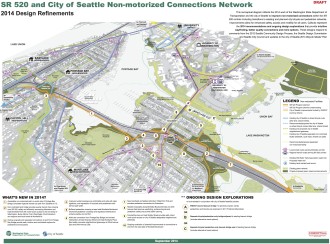 Plans for the state’s megaproject to replace the SR 520 Bridge are getting better in many ways, but major gaps in the walking and biking environment still remain, especially in the Montlake area.
Plans for the state’s megaproject to replace the SR 520 Bridge are getting better in many ways, but major gaps in the walking and biking environment still remain, especially in the Montlake area.
The majority of the project’s Seattle end remains unfunded, but the state is moving forward with design work in hopes the legislature steps up and provides the more than one billion dollars still missing.
The state presented some updated concepts for some pretty good new trail connections around the project this week, including a connection on the Portage Bay Bridge to Capitol Hill and new Lake Washington Loop and Arboretum links. But the project is still a highway expansion project, and plans include some huge intersections and a very wide, car-packed Montlake Boulevard.
There are also no clear plans for a new biking and walking connection across the ship canal, which is needed since they cannot widen the historic Montlake Bridge to accommodate the ever-increasing number of people biking and walking between Montlake and UW.
The Good
First up, let’s look at the good stuff. The state’s glossy concept image makers have been pumping out some very high quality stuff showing off the improved biking and walking connections. You can see these images and their context in the presentation PDFs at the bottom of this post.
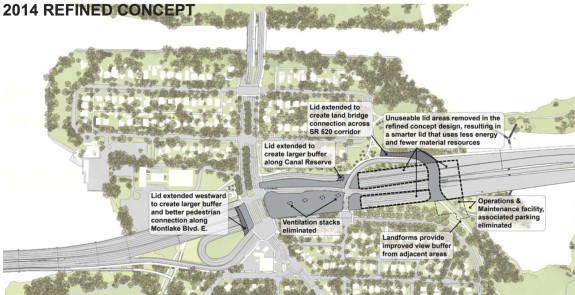 The biggest change to the Montlake area is a new bridge to provide a quality trail connection from the Arboretum/Lake Washington Boulevard across the expanded highway. Here’s what that could look like from the sky looking southwest.
The biggest change to the Montlake area is a new bridge to provide a quality trail connection from the Arboretum/Lake Washington Boulevard across the expanded highway. Here’s what that could look like from the sky looking southwest.
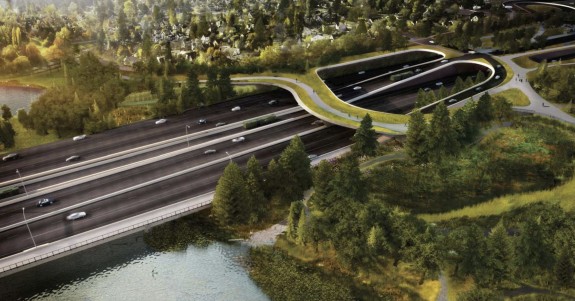 And from this view you can see the new trail beyond Lake Washington Boulevard, looking north:
And from this view you can see the new trail beyond Lake Washington Boulevard, looking north:
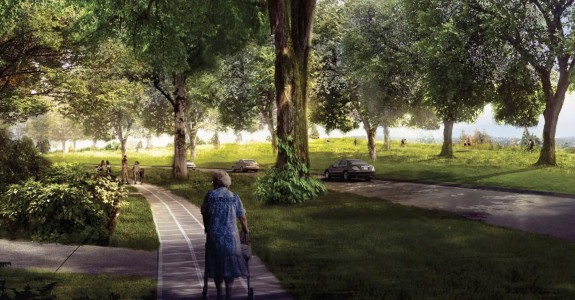 Below is what planners are now imaging for the Bill Dawson Trail (the existing dark and skinny trail that travels under 520 just west of Montlake Boulevard. Yes, it has a name). This view looks east from the 520 underpass toward a new Montlake Boulevard underpass. The ramp on the left is how you will get up to the west sidewalk of the Montlake Bridge.
Below is what planners are now imaging for the Bill Dawson Trail (the existing dark and skinny trail that travels under 520 just west of Montlake Boulevard. Yes, it has a name). This view looks east from the 520 underpass toward a new Montlake Boulevard underpass. The ramp on the left is how you will get up to the west sidewalk of the Montlake Bridge.
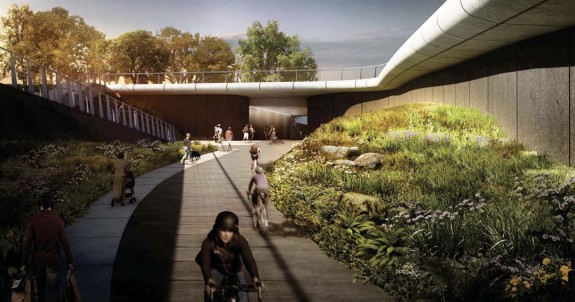 The next view looks at the new transit stop on the Montlake Lid, which will replace the (totally not ADA accessible) flyover stop that exists today. Paths lead to and from the Lake Washington Loop bike route across a new lid over the freeway, which is all good. What this image conveniently crops out is the massive size of Montlake Boulevard just right of the frame, where the street has a remarkable nine lanes, three more lanes than it has today.
The next view looks at the new transit stop on the Montlake Lid, which will replace the (totally not ADA accessible) flyover stop that exists today. Paths lead to and from the Lake Washington Loop bike route across a new lid over the freeway, which is all good. What this image conveniently crops out is the massive size of Montlake Boulevard just right of the frame, where the street has a remarkable nine lanes, three more lanes than it has today.
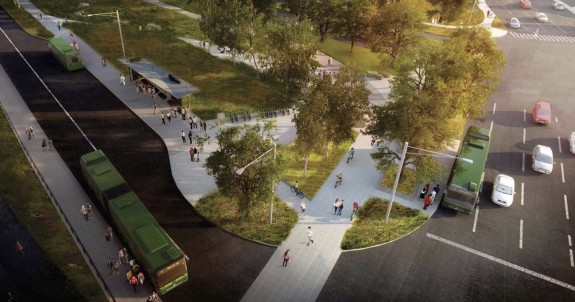 The concept for the shoreline trail connecting from Lake Washington Boulevard to Marsh Island under the 520 Bridge has also been greatly improved. While passing under a dozen or so lanes of an expanded SR 520 is probably not going to be as pristine experience as this image shows, it does seem like a pretty fun trial connection.
The concept for the shoreline trail connecting from Lake Washington Boulevard to Marsh Island under the 520 Bridge has also been greatly improved. While passing under a dozen or so lanes of an expanded SR 520 is probably not going to be as pristine experience as this image shows, it does seem like a pretty fun trial connection.
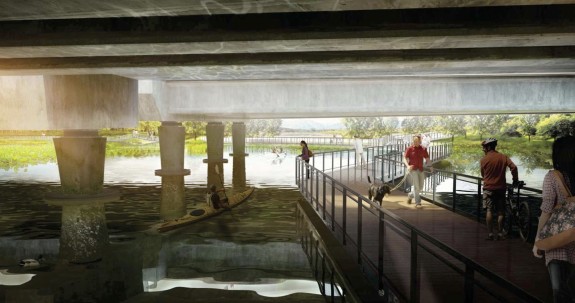 And it’s true, project planners are now planning a biking and walking trail with a gradual grade across the Portage Bay Bridge to connect up to Roanoke Park, Interlaken Park and Capitol Hill from Montlake. They have two designs in the works. Here’s what the cable stay bridge option would look like from the path:
And it’s true, project planners are now planning a biking and walking trail with a gradual grade across the Portage Bay Bridge to connect up to Roanoke Park, Interlaken Park and Capitol Hill from Montlake. They have two designs in the works. Here’s what the cable stay bridge option would look like from the path:
The Bad
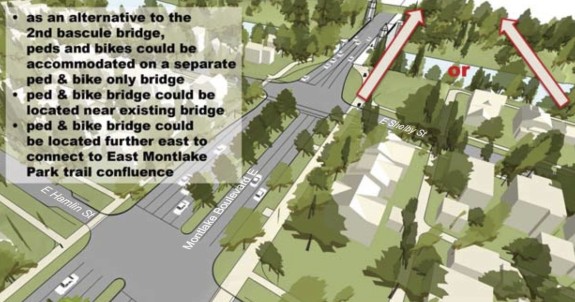 There is still no clear plan for an improved Ship Canal crossing for people biking and walking from Montlake to UW, including UW Station and the Burke-Gilman Trail. This probably would mean building a new bike/walk bridge either adjacent to the existing Montlake Bridge or further east to meet up with the new trail network. The good news is that the need is on planners’ radar. The bad news is that the state has not fully committed to funding it, despite a city study that the existing conditions are already beyond capacity for current walking and biking levels.
There is still no clear plan for an improved Ship Canal crossing for people biking and walking from Montlake to UW, including UW Station and the Burke-Gilman Trail. This probably would mean building a new bike/walk bridge either adjacent to the existing Montlake Bridge or further east to meet up with the new trail network. The good news is that the need is on planners’ radar. The bad news is that the state has not fully committed to funding it, despite a city study that the existing conditions are already beyond capacity for current walking and biking levels.
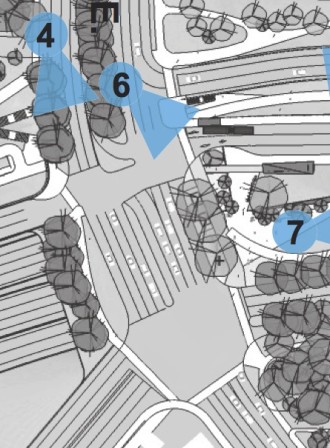 And the worst part of the plan remains Montlake Boulevard itself and the expanded on and off ramps to the freeway. There are too many lanes to create a comfortable and safe space for people walking or biking. It is being designed as though Montlake Boulevard is a highway, not a major neighborhood commercial street (it is technically SR 513, but it should be treated like a neighborhood commercial street). Plans include dramatically expanded space for cars at the expense of everyone else.
And the worst part of the plan remains Montlake Boulevard itself and the expanded on and off ramps to the freeway. There are too many lanes to create a comfortable and safe space for people walking or biking. It is being designed as though Montlake Boulevard is a highway, not a major neighborhood commercial street (it is technically SR 513, but it should be treated like a neighborhood commercial street). Plans include dramatically expanded space for cars at the expense of everyone else.
This not only includes Montlake residents, but also regional residents coming across the new 520 Trail or the Lake Washington Loop bike route, people connecting from the 520 buses to UW Station, people heading to and from UW and the Burke-Gilman Trail, and people coming down from Capitol Hill on the new Portage Bay Trail.
Today, Montlake Boulevard is six lanes wide as it crosses 520, and it is an extremely stressful and uncomfortable environment. The state’s plans would add another three lanes, bringing the total to nine. The Montlake Bridge will remain four lanes to the north and there is neighborhood pressure to make 24th Ave safer to the south through Montlake and up to Capitol Hill and the CD by changing it to three lanes.
There are no plans for a complete trail or protected bike lanes on Montlake Boulevard itself despite the fact that would be the most direct connection to the transit stops, the commercial core of Montlake and the planned neighborhood greenways there. Crossing the wide on and off ramps will not be comfortable on foot or bike.
So while planners have come a long, long way from original plans (which did not include the Portage Bay Trail and put many of the trail connections into dark trenches), this is still a highway expansion project, and the core changes to Montlake Boulevard itself remain either neutral or a downgrade for the walking and biking environment (if you can imagine that). It’s great that planners have clearly listened to people’s concerns about the trail connections. Now we just need to address Montlake Boulevard, the most difficult and important piece.
Seattle Neighborhood Greenways (with the help of Montlake, Madison and Central groups as well as Cascade Bicycle Club) put it this way in a recent list of project suggestions:
Reclaim Montlake Boulevard as part of the Olmsted legacy. Montlake Boulevard is proposed to function as a surface highway. Instead we must reclaim the Olmsted legacy of enjoyable connections between parks, and create comfortable options for people walking or biking. A multi-use trail or expanded sidewalks and a protected bike lane would fulfill this need.
Below are some documents from the recent 520 meeting. You can see more on the state’s project website.

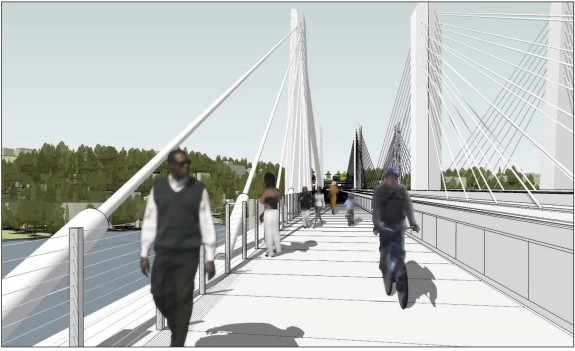








Comments
11 responses to “Biking and walking details improving around 520 Bridge project, still has major gaps”
‘ The state’s plans would add another three lanes, bringing the total to nine.”
That’s just nuts. Considering all the pedestrians and people who go to the University for events at the stadiums to put a massive interchange in with bottlenecks at all possible exits seems extremely wasteful of the highway money and won’t solve the traffic problems.
Ugh ugh ugh, it’s still a 9-lane highway hammered into lakes and bays and wetlands. Doubling the width and doubling the volume and doubling the noise. Yes, Montlake will be prettier in places, but it will be more desolate in others, and more unusable everywhere. Their map shows bus lines in all directions from Montlake, including ones that run hourly and are slated to be cut (like #25), making it look like there’s more transit accommodation than there is. And there is no reason to build a direct exit ramp to Lake WA Blvd (call it the RH Thompson memorial offramp?) Yes, this is an improvement, but every time I see the designs I want to cry. Why are we still building these beautified monstrosities in the 21st century?
Is that off-ramp new to the plan? I don’t remember it being there before. I remember thinking that removing the direct access would make LWB through the Arboretum nicer.
Also, they seem to be trying to sneak in a much wider Portage Bay bridge along with the path. And I had totally missed the whole “managed shoulder” thing, essentially a sneaky way to add vehicle capacity to WB 520 that downtown Seattle can’t handle (I say this as if additional vehicle capacity wasn’t something to oppose on its own merits). The Portage Bay Bridge plans here are 7 lanes plus the trail!
Instead of focusing on the number of lanes, I think the correct place to focus is on tolling single occupant cars on I-90. In the ideal world, carpools and buses would get a free pass over the bridges, and single occupant tolls would be set high enough to eliminate all regular backups. If they do that then I’ll support this plan and most any other reasonable variation that SDOT puts forward to a vote. If they decide to push this all into a regressive sales tax or focus tolling only on 520 then I’ll oppose any funding.
There’s nothing wrong with tolling, but tolling I-90 doesn’t really solve any problems at 520/Montlake. It doesn’t make the interchange any less of a noisy, polluted place, doesn’t make homes and businesses along Montlake Blvd. walkable, doesn’t reduce the amount of speeding traffic on Lake Washington Boulevard, doesn’t answer the questions about transit service on the lid in any direction (many local and regional routes are at risk of cuts, and it’s likely many routes will skip the lid stop at least during the forward peak, resulting in less commuter bus service between the eastside and Montlake/UWMC).
As I see it, if the two bridges have the same toll structure set on single occupant cars high enough then it will have a dramatic effect. It will discourage people from driving between the two bridges to avoid tolls, it will deter people from commuting alone, it will eliminate wasteful backups approaching the bridges, it will speed bus and carpool transit, and it will raise a huge chunk of the money to pay for all this work.
On the flip side, any further tweaking to the design at Montlake is only going to shift choke points around as there are way too many drivers wanting to cross the bridges, so it’s a question of where the backups will be.
And if we set tolls high enough to achieve free-flowing traffic on 520 and I-90 all day, but continue to expand highways at every opportunity, what have we really achieved? Little if any reduction in pollution. Little improvement in the safety and convenience of any alternative to driving. We’ve simply made regional mobility selectively accessible by income level. For the sake of social justice strong alternatives should accompany tolling.
The design at Montlake is already going to shift chokepoints by expanding the freeway and interchanges. An expanded interchange may be worse for local transit (mostly the 48) as more of the limited space on the Montlake Bridge is used by traffic exiting the freeway at higher peak rates (and even higher sustained rates, given the expansion of the bridges on both sides of Montlake). If we respond to that with an extra bridge over the Ship Canal new chokepoints could be created over there as well. Every design tweak WSDOT makes is tweaking more vehicle capacity in, moving the traffic pressure onto a different road they’ll then propose to expand in the future. This is how highway expansion has worked for a century, and it has to be stopped whether tolling happens or not.
[…] arrogance of space: Everything and more that you wanted to know about the unfunded SR-520 plans for the Montlake-to-I-5; there are some big changes in WSDOT’s latest revision. Mostly, WSDOT’s plan is […]
It could have been a great transfer point between Link and east side bus service, keeping those vehicles off the Montlake bridge and even the freeways into downtown. And with the new bike connections it would’ve been a great spot to start or end a ride. It’s really too bad the transit agencies don’t work together.
[…] fund the replacement portion of SR-520 in Seattle and get it right… (But hey, apparently WSDOT staff hate bicyclists, buses, and pedestrians. Go […]
[…] other side of the lake). This is slated to open to drivers and cyclists in summer 2017. A lot of design work has been done on the remainder of the Montlake side, but at this point nothing else has been approved nor […]